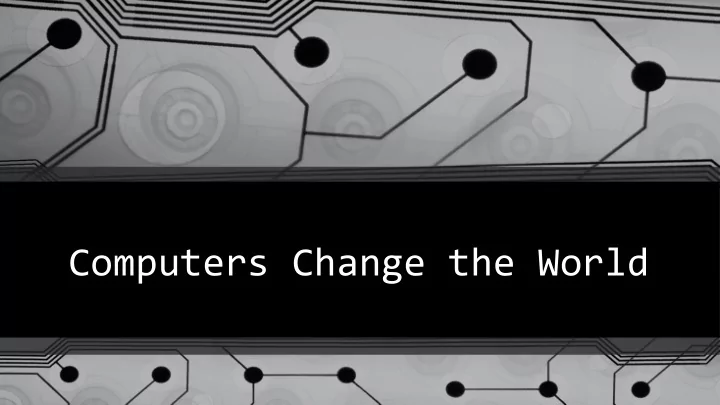

Computers Change the World
Computing is Changing the World Activity 1.1.1 Computing Is Changing the World • Students pick a grand challenge and consider how mobile computing, the Internet, Big Data, and simulation are contributing to solving that challenge. • Primary goals for the activity, project, or problem: • Establish the course as an exploration of the impact of computing • Consider how computing will impact what is important to you
Computing Milestones • 1971 The first personal computer • 1991 The first web page • 2002 The first broadband mobile network • 2007 The first smart phone • 2016 Car manufacturers working on autonomous automobiles
Food for Thought • Can you think of a single career or hobby that has not been changed by computing? • How do you think computing has made people's lives better or worse? • How will the future be different?
Ultimate Goal I will walk you through a thorough thought process to assist you in developing your app. Our Goal: • Together with your partner, present briefly to the class. Name the problem you identified in step 3 (I’ll tell you when we get there) and the ideas you recorded in steps 4 and 5.
Learning to Greet Professionally Part of learning CS is learning to present yourself seriously to potential interested adults in your thoughts / program / app. • Squaring your shoulders and knees with the person you are greeting and using good posture (shoulders straight) • Making eye contact • Smiling • Using an enthusiastic, interested voice • Saying something pleasant, like “Nice to meet you,” or “I am glad to be working with you,” or “I look forward to working with you.”
Team Norms • Respect team mates, Be prepared, and Be positive When I ask you to collaborate or create a written response, I mean that I would like you to: 1. Think about the question 2. Each says something to contribute to a discussion 3. Write down our answers. Our answers can be similar or different.
Computational Thinking In this unit, you will create an app to help meet a need in your community, and to help solve a local problem. Computational thinking - is a way of thinking about how computing power can help solve a problem. Before acting locally, think globally about how computing can help solve a problem. End Day 1
Step 3 Pick one problem of interest to you. Describe the problem. Write /type your thoughts (label it step 3)
Small Group What are some important problems to be solved in the modern world? • Discuss with person next to you • Be prepared to share your discussion in class
Step 4 Thoughts Label this on your notes as Step 4
Ways CS fulfills needs/creates solutions 1. Collecting and analyzing data - often helps solve a problem. • HOW ? Computation is creating huge amounts of data, from web traffic to cameras and sensors. • APPLY : How could collecting and analyzing data help people solve the problem you named? 1 of 4
Ways CS fulfills needs/creates solutions 1. Modeling and simulation - often help solve problems by: • HOW? helping us understand, discuss, and predict changes in physical, biological, or social systems. • APPLY: How might simulation help solve the problem you named? 2 of 4
Ways CS fulfills needs/creates solutions 1. Automation is possible because of computing. • APPLY : How could automation contribute to the solutions for the problem you named? 3 of 4
Ways CS fulfills needs/creates solutions 1. A daptive technology - Computing can extend people's abilities. • HOW ? Like prosthetic arms that move in response to brain waves. Beyond adaptive technology, computing will continue to extend human abilities beyond any prior human ability. Whispering eyeglasses will help your memory during conversation; contact lenses will overlay information onto what you see. • APPLY : How could extending people's abilities help solve the problem you identified? 4 of 4
Step Five Label this as Step Five in your notes
CS Changes our Approach to Problems and Solutions • Computing has changed creative expression through easy access to digital authoring tools. RECORD: How might this contribute to the solution of the problem you identified? 1 of 3
CS Changes our Approach to Problems and Solutions • Computing has changed the way people share information and collaborate . RECORD: How might this contribute to the solution of the problem you identified? 2 of 3
CS Changes our Approach to Problems and Solutions • Computing changes the way people relate to one another, socially and economically. RECORD: Describe how the social and economic impact of computing might improve or worsen the problem you have named. 3 of 3
Final Presentation Share your Thoughts
Finalize your Collaboration Together with your partner, present briefly to the class. Name the problem you identified in step 3 and the ideas you recorded in steps 4 and 5
Essential Questions 1. How has computing affected the world we live in? 2. Why is it advantageous to break a problem down into smaller pieces and build a solution incrementally? 3. How do computers represent the data in words, numbers, pictures, and sound?
Recommend
More recommend